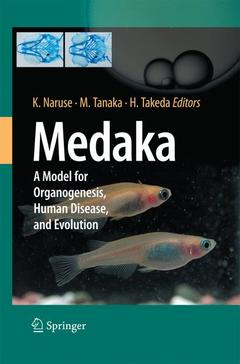Description
Medaka, 2011
A Model for Organogenesis, Human Disease, and Evolution
Coordinators: Naruse Kiyoshi, Tanaka Minoru, Takeda Hiroyuki
Language: English
Subjects for Medaka:
Publication date: 10-2014
387 p. · 15.5x23.5 cm · Paperback
Publication date: 06-2011
387 p. · 15.5x23.5 cm · Hardback
Description
/li>Contents
/li>Comment
/li>
Oryzias latipes, known as medaka, is a model organism from East Asia. Breeding of this small, egg-laying freshwater teleost fish has long been popular among hobbyists in Japan. Now, as biological science has entered the genome era, the medaka provides significant advantages that make it one of the most valuable vertebrate models: a large collection of spontaneous mutants collected over a century, the presence of highly polymorphic inbred lines established over decades, and a recently completed genome sequence. This book is the first comprehensive monograph to cover a variety of medaka research. It opens with a historical view of medaka, followed by a series of research topics in the four major areas where the medaka is increasingly important: genomics, genetics, and resources; organogenesis and disease models; germ cells, sex determination, and reproduction; and evolution. Readers will find state-of-the-art information on medaka genetics and genomics such as the first isolation of active transposons in vertebrates, the influence of chromatin structure on sequence variation, fine QTL analysis, and versatile mutants as human disease models.
The first book to cover the expanding research on medaka
Describes recent progress in the field and provides a good introduction of this fish system along with information on the long history of medaka in Japanese culture and science
Biological and genome resources are listed with accessible web sites, especially helpful for new researchers in the field
Includes supplementary material: sn.pub/extras
These books may interest you

Zebrafish, Medaka, and Other Small FishesNew Model Animals in Biology, Medicine, and Beyond 189.89 €

Zebrafish, Medaka, and Other Small FishesNew Model Animals in Biology, Medicine, and Beyond 189.89 €

Sex Determination in Vertebrates 166.19 €

